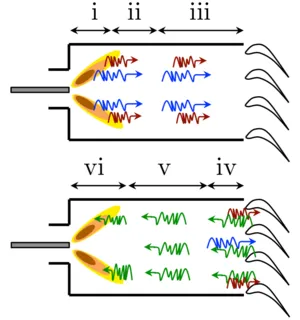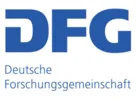NoiSI - Combustion Noise and Dynamics of Partially Premixed Flames
Motivation
Combustion noise and in particular combustion instability are two significant problems for the development of reliable, low emission jet engines. Compared to other types of aeronautical noise, the relative importance of combustion noise has increased in the last decades. Thermoacoustic combustion instability is a design challenge that must be confronted as aero engine combustion moves towards lean operating conditions in order to satisfy emission regulations on pollutants (mainly NOx and CO). Consequently, the development of modeling concepts and simulation tools to investigate and control these two phenomena - which are closely related to each other on a fundamental level - becomes mandatory for the design of future engines that have to be clean, quiet, stable and capable of working over a wide range of operating conditions. This project will combine leading-edge system identification (SI) techniques with high-fidelity numerical simulation of turbulent reacting multiphase flow in order to create efficient numerical methodologies to assess combustion instability of partially premixed flames as well as sources of direct and indirect combustion noise. This approach is also manifested in the name of the project: NoiSI (Noise & System Identification).
A joint project between Laboratoire EM2C, CentraleSupélec, Paris and TUM developed and validated tools for the simulation and identification of the dynamics of confined turbulent premixed flames as well as the corresponding sources of direct combustion noise. In continuation of these efforts, the project NoiSI will advance significantly the state of the art. Instead of perfectly premixed flames, partially premixed flames and in particular spray flames will be considered. The analysis will be based on an extended MIMO flame model structure with fluctuations of velocity and equivalence ratio as inputs and fluctuations of heat release rate and entropy (or temperature) as outputs. The generation, transport and dispersion of entropy waves will be taken into acount, such that the impact of entropy waves on thermoacoustic stability and indirect combustion noise can be quantified.
The acquired results from numerical simulations and modeling strategies will be cross-validated against experimental data of a high-pressure, liquid fuel combustor at Institute of Propulsion Technology, DLR, Cologne and a lab-scale, gaseous fuel combustor at CAPS, ETH Zurich.
Objectives and Strategy

The main objective of this project is the development and validation of a general unified framework to model combustion noise and thermoacoustic instability in aeronautical gas turbines. This framework relies on data-based, reduced order models of flame dynamics and combustion noise, and is conceived to remain computationally affordable also for configurations of applied interest. It comprises three steps:
High-fidelity numerical simulation: Compressible large eddy simulation (LES) of confined turbulent partially premixed swirl flames with acoustic broadband forcing will be performed. Boundaries with non-trivial acoustic impedance will be modeled using characteristic-based state-space boundary conditions (CBSBC) [1].
Advanced system identification: The flame dynamics and the sources of direct as well as indirect combustion noise will be evaluated by means of advanced system identification techniques, i.e. a form of supervised machine learning. The combination of this statistics-based approach and LES allows to predict the flame transfer function (FTF) for a wide range of frequencies from a single broadband LES time series data set. The model of the MIMO (multiple-inputs, multiple-outputs) system under investigation will be based on a Box-Jenkins (BJ) model [2], which is a generalization of the finite impulse response (FIR) architecture. In addition to the deterministic part, BJ includes also the estimation of a stochastic process, which is necessary for simultaneous identification of the FTF and noise source [3].
Reduced order acoustic network modeling: A thermoacoustic network model of the combustor acoustics [4] will be established that takes into account all physical mechanisms relevant for combustion noise (see Fig. 1) and instability margins of turbulent flames by incorporating the sources and flame responses evaluated previously with LES/SI approach.
Selected Publications
[1] Jaensch, S., Sovardi, C., Polifke, W., 2016. On the Robust, Flexible and Consistent Implementation of Time Domain Impedance Boundary Conditions for Compressible Flow Simulations. Journal of Computational Physics 314, 145-159.
[2] Merk, M., Gaudron, R., Silva, C. F., Gatti, M., Mirat, C., Schuller, T., Polifke, W., 2019. Prediction of Combustion Noise of an Enclosed Flame by Simultaneous Identification of Noise Source and Flame Dynamics. Proceedings of the Combustion Institute 37, 5263-5270.
[3] Merk, M., Jaensch, S., Silva, C., Polifke, W., 2018. Simultaneous Identification of Transfer Functions and Combustion Noise of a Turbulent Flame. Journal of Sound and Vibration 422, 432-452.
[4] Silva, C. F., Merk, M., Komarek, T., Polifke, W., 2017. The Contribution of Intrinsic Thermoacoustic Feedback to Combustion Noise and Resonances of Confined Turbulent Premixed Flame. Combustion and Flame 182, 269-278.
Acknowledgement
The financial support by the German Research Foundation (Deutsche Forschungsgemeinschaft - DFG, project number 442581657) is gratefully acknowledged. This transfer project is carried out in collaboration with Rolls-Royce Deutschland Ltd & Co KG, Blankenfelde-Mahlow, Germany, whose coorporation is highly appreciated.

